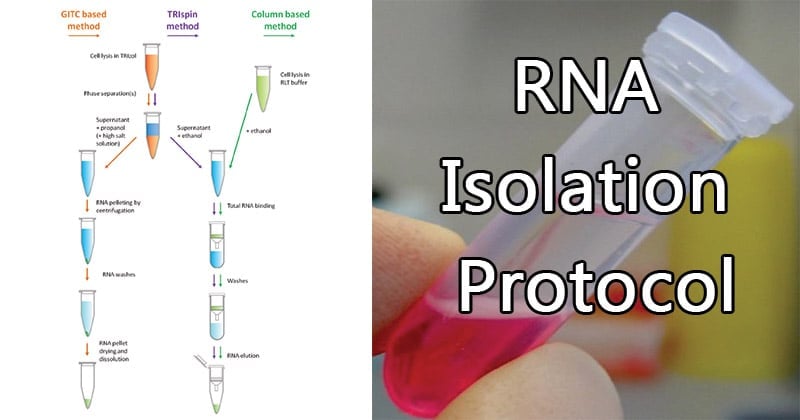Interesting Science Videos
Total RNA isolation from Bacterial Cells
Principle of RNA Isolation
Total RNA is isolated and separated from DNA and protein after extraction with a solution called as Trizol. Trizol is an acidic solution containing guanidinium thiocyanate (GITC), phenol and chloroform. GITC irreversibly denatures proteins and RNases. This is followed by centrifugation. Under acidic conditions, total RNA remains in the upper aqueous phase, while most of DNA and proteins remain either in the interphase or in the lower organic phase. Total RNA is then recovered by precipitation with isopropanol. RNase enzymes can be inactivated by including diethyl pyrrocarbonate (DEPC).

Materials Required for RNA Isolation
- Bacterial culture
- Trizol
- Chloroform
- Isopropanol solution
- TAE buffer
- 70% ethanol
Procedure of RNA Isolation
- Take 800 μL of bacterial culture in a fresh eppendorf.
- To this add 160 μL of Trizol (1/5th of culture volume).
- The solution was mixed well by pipetting several times.
- To this add 32 μl of chloroform (1/5th volume of trizol).
- Incubate for 2 to 5 minutes and centrifuge at 12000 rpm for 15 minutes at 4° C
- Transfer the aqueous phase into a new tube and add equal volume of isopropanol. Mix well.
- Centrifuge at 10000 rpm for 10 minutes at 4° C.
- Discard the supernatant and resuspend the pellet in 70% ethanol. • Again centrifuge at 10000 rpm for 10 minutes at 4° C.
- Discard the supernatant.
- Air dry the pellet at 37° C for 10-15 minutes.
- Resuspend the pellet in 50 μL of TE buffer.
- Analyse the RNA sample quantitatively and qualitatively.
Isolation of RNA from Animal Cells or Tissues
Materials Reagents
- TRIzol reagent
- Chloroform
Instruments
- Fume hood
- Vortexer
- Micropipettes
- Chilled microcentrifuge
- Pellet pestle homogenizer
Procedure
- Clean the workstation (pipettor shaft, benchtop) with a surface decontamination solution that destroys RNases.
- Chill the microcentrifuge to 4 ºC.
- Homogenization fresh tissue or cell culture:
- Fresh tissue is preferable for optimal RNA isolation. Alternatively, tissue should be submerged in RNA stabilization reagent immediately after dissection and stored at –80 °C.
- Add 1 ml TRIzol reagent per 100 mg fresh tissue, mince on ice using sterile scalpels, and homogenize with a sterile pellet pestle probe.
- In case of cell cultures, they should be processed immediately after removal from the incubator.
- Either centrifuge cells grown in suspension at 300 x g for 5 min at RT (15-25 ºC) and discard supernatant or remove the culture medium from cells grown in monolayer.
- Add 1 ml TRIzol reagent per 1 × 107 cells to cell pellets or directly to the culture dish or flask for cells grown in monolayer. Resuspend the lysate with a sterile, disposable 1-ml pipette tip.
- Transfer the tissue or cell lysate to a 2-ml siliconized low-retention tube.
- Pass sample through sterile, disposable 21 g needle 10 times. In doing so, high-molecular weight cellular components (DNA) are fragmented, thus minimizing their presence in the aqueous phase.
- Let homogenate sit at RT (15-25 ºC) for 5 min for complete dissociation of nucleoprotein complexes.
- Let homogenate sit at RT (15-25 ºC) for 3 min.
- Centrifuge at 12,000 x g for 15 min at 4°C. After centrifugation, heat the centrifuge to room temperature (15–25°C).
- Transfer upper aqueous phase (600 ul) to new 1.5 ml RNase-free tube.
- Proceed to alcohol precipitation.
- Precipitate the RNA from the aqueous phase by mixing with isopropyl alcohol. Use 0.5 ml of isopropyl alcohol per 1 ml of TRIZOL Reagent used for the initial homogenization.
- Incubate samples at 15 to 30oC for 10 minutes and centrifuge at not more than 12,000 x g for 10 minutes at 2 to 4oC.
- Remove the supernatant completely. Wash the RNA pellet once with 75% ethanol, adding at least 1 ml of 75% ethanol per 1 ml of TRIZOL Reagent used for the initial homogenization.
- Mix the samples by vortexing and centrifuge at no more than 7,500 x g for 5 minutes at 2 to 8 oC. Repeat.
- Air-dry or vacuum dry RNA pellet for 5-10 minutes.
- Dissolve RNA in DEPC-treated water by passing solution a few times through a pipette tip.
- Subject to spectrophotometric analysis to determine sample concentration and purity.
Expected Results
- A gel-like pellet on the side and bottom of the tube of RNA precipitate.
- On taking OD at 260 nm and 280 nm, the A260/A280 ratio should be above 1.6.
Reference
- http://www.srmuniv.ac.in/sites/default/files/files/BT0210%20%20MOLECULAR%20BIOLOGY%20LABORATORYMANUAL.pdf
- Chomczynski P and Sacchi N. “The single-step method of RNA isolation by acid guanidinium thiocyanate–phenol–chloroform extraction: twenty-something years on”. Nature Protocols 1(2): 581-585; 2006.
- Cox RA and Arnstein HRV. Biochem. “The isolation, characterization and acid–base properties of ribonucleic acid from rabbit-reticulocyte ribosomes”. J. 89, 574; 1963.
- http://physiology.med.cornell.edu/faculty/mason/lab/zumbo/files/PHENOL-CHLOROFORM.pdf
- https://www.labome.com/method/RNA-Extraction.html
- http://www2.lbl.gov/LBLPrograms/lifesciences/BissellLab/labprotocols/rnaextraction.htm
- https://medicine.yale.edu/keck/ycga/microarrays/protocols/TRIZOLRNAIsolation_092107_21453_284_10813_v1.pdf
